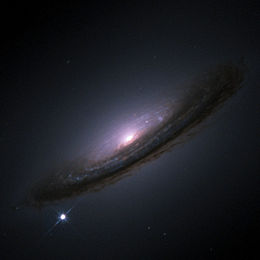Supernova
A supernova is a transient astronomical event that occurs during the last stellar evolutionary stages of a massive star's life, whose destruction is marked by one final titanic explosion. This causes the sudden appearance of a "new" bright star, before slowly fading from sight over several weeks or months.

SN 1994D (bright spot on the lower left), a Type Ia supernova outshining its home galaxy, NGC 4526
Supernovae are more energetic than novae. In Latin, nova means "new", referring astronomically to what appears to be a temporary new bright star. Adding the prefix "super-" distinguishes supernovae from ordinary novae, which are far less luminous. The word supernova was coined by Walter Baade and Fritz Zwicky in 1931.
Only three Milky Way naked-eye supernova events have been observed during the last thousand years, though many have been seen in other galaxies using telescopes. The most recent directly observed supernova in the Milky Way was Kepler's Supernova in 1604, but two more recent supernova remnants have also been found. Statistical observations of supernovae in other galaxies suggest they occur on average about three times every century in the Milky Way, and that any galactic supernova would almost certainly be observable with modern astronomical telescopes.
Supernovae may expel much, if not all, of the material away from a star[2] at velocities up to 30,000 km/s or 10% of the speed of light. This drives an expanding and fast-moving shock wave[3] into the surrounding interstellar medium, and in turn, sweeping up an expanding shell of gas and dust, which is observed as a supernova remnant. Supernovae create, fuse and eject the bulk of the chemical elements produced by nucleosynthesis.[4] Supernovae play a significant role in enriching the interstellar medium with the heavier atomic mass chemical elements.[5] Furthermore, the expanding shock waves from supernovae can trigger the formation of new stars.[6][7] Supernova remnants are expected to accelerate a large fraction of galactic primary cosmic rays, but direct evidence for cosmic ray production was found only in a few of them so far.[8] They are also potentially strong galactic sources of gravitational waves.
Theoretical studies indicate that most supernovae are triggered by one of two basic mechanisms: the sudden re-ignition of nuclear fusion in a degenerate star or the sudden gravitational collapse of a massive star's core. In the first instance, a degenerate white dwarf may accumulate sufficient material from a binary companion, either through accretion or via a merger, to raise its core temperature enough to trigger runaway nuclear fusion, completely disrupting the star. In the second case, the core of a massive star may undergo sudden gravitational collapse, releasing gravitational potential energy as a supernova. While some observed supernovae are more complex than these two simplified theories, the astrophysical collapse mechanics have been established and accepted by most astronomers for some time.
Due to the wide range of astrophysical consequences of these events, astronomers now deem supernova research, across the fields of stellar and galactic evolution, as an especially important area for investigation.
I think we should understand a lot about quantum physics which will provide us a big vision about the universe and galaxy..
Congratulations @fanservice! You have completed some achievement on Steemit and have been rewarded with new badge(s) :
Click on any badge to view your own Board of Honor on SteemitBoard.
For more information about SteemitBoard, click here
If you no longer want to receive notifications, reply to this comment with the word
STOP